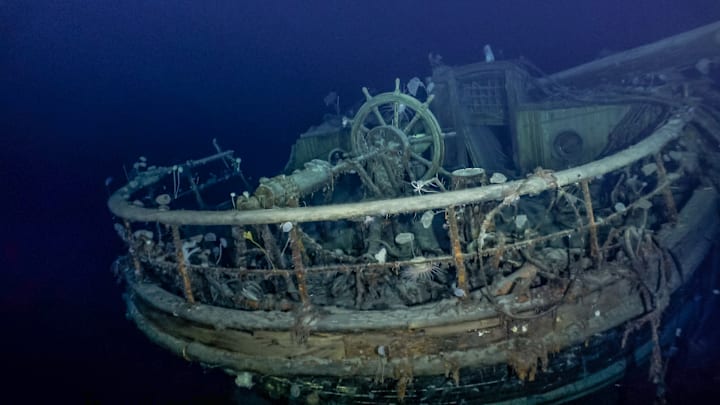When Sir Ernest Shackleton and 27 crew members set sail from Buenos Aires in October 1914, they hoped to be the first expedition to trek across Antarctica in its entirety. Instead, they ended up gaining fame for something else: simply surviving.
In January 1915, their ship, the Endurance, got lodged in pack ice. As it drifted along over the next 10 months, it was slowly crushed—and finally swallowed by the sea on November 21, 1915. The men then camped out on ice floes for four months and, once the ice began to melt, made for the minuscule Elephant Island in lifeboats. Within 10 days of reaching it, Shackleton and a handful of men headed back out to sea in search of rescue. About 800 miles and two weeks later, they landed on the glacial island of South Georgia and were forced to traverse it on foot to get to the whaling station on its opposite coast. The journey nearly killed them, but they made it, and Shackleton collected the rest of the men from Elephant Island in August. Astonishingly, none had died in the interim.
The entire ordeal is one of the most thrilling survival stories of all time, and Shackleton went down in history as the leader who “never lost a man” (under his direct command, at least). He did, however, lose the Endurance. And for the last 107 years, the location of the 144-foot wooden vessel has remained a mystery.

Now, as CNN reports, the wreck has been discovered 3008 meters (nearly two miles) below the surface of the Weddell Sea off Antarctica’s northern coast. It’s roughly four miles south of the spot where the ship’s captain, Frank Worsley, had recorded its sinking. The search party—aptly named the Endurance22 Expedition—was helmed by the Falklands Maritime Heritage Trust and departed from Cape Town, South Africa, in February. To say that the researchers were excited by their find would be an understatement.
“I’ve been excavating, surveying, evaluating wrecks since my mid-twenties, but I’ve never, ever seen a wreck anything like as beautiful and as inspiring as this one,” Mensun Bound, the expedition’s director of exploration, said in an interview for the BBC.
The ill-fated ship is in remarkably good condition; the word Endurance and a North Star ornament are even still affixed to its stern. “You would have to be made of stone not to feel a bit squishy at the sight of that star and the name above,” Bound added.

The Endurance is so well-preserved in part because the Weddell Sea is frigid and completely devoid of wood-consuming marine parasites. It was also just an exceptionally well-constructed vessel. “I thought, ‘If there’s any wood-built ship that could survive the impact with the sea bed, it would be the Endurance,’” Bound said.
Before the ship sank, some crew members hacked holes in the deck floor so they could fish out supplies with hooks instead of having to go belowdecks. Those holes are clearly visible in the wreck—as are certain things that got left behind, including boots and kitchenware. Bound kept his eyes peeled for a bicycle that belonged to crew member Thomas Orde-Lees and the honey jars in which biologist Robert Clark stored zoological specimens, but to no avail.
While the Endurance22 team captured plenty of photos and video footage of the shipwreck, their deep-sea equipment didn’t touch a thing. Thanks to the Antarctic Treaty, first signed in 1959, the Endurance is automatically considered a Historic Site and Monument, and therefore can only be surveyed. As for what other fascinating details those surveys may have uncovered, stay tuned for a documentary on the expedition, set to premiere on National Geographic this fall.
[h/t CNN]
